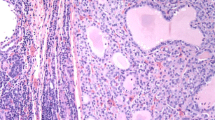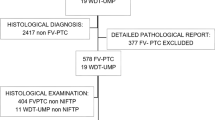Abstract
Previous data has shown that the risk of nodal metastases is significantly greater for classical papillary thyroid carcinoma (PTC) as compared to the follicular variant (FVPTC). Given a recent change in diagnostic paradigm and definition of the noninvasive follicular thyroid neoplasm with papillary-like nuclear features (NIFTP) we intended to investigate if there remains a significant difference in nodal involvement between classical PTC and FVPTC. A 6-year retrospective review of all cases with FVPTC in the diagnostic line from the University of Utah/ARUP Laboratories was conducted. Two pathologists reviewed the remaining cases using the recently described histologic criteria of NIFTP to determine the total number the FVPTCs fitting the new classification paradigm. Histologic and clinical follow-up was tracked for all patients to determine the rate of nodal disease for all groups. 127 cases were identified using the above listed criteria. Forty-seven cases (37%) were classified as NIFTPs. None of the 47 patients had nodal disease either at the time of surgery or on follow-up. Twenty-eight cases met the current criteria for FVPTC (21%); of these 7/28 (25%) had evidence of nodal disease. By comparison, 17/45 (38%) of patients with mixed classical and FVPTC had nodal disease. Overall, there was no statistically significant difference in the risk of nodal metastasis between the pure FVPTC and mixed classical/FVPTC groups (p = 0.43). Our data indicates that implementing new definition for FVPTC will narrow the gap in the risk of nodal metastases between the classical PTC and FVPTC histologic subtypes.

Similar content being viewed by others
References
Hundahl SA, Fleming ID, Fremgen AM, MenckHR. A national cancer data base report on 53,856 cases of thyroid carcinoma treated in the US, 1985–1995. Cancer. 1998;83:2638–48.
Pellegriti G, Frasca F, Regalbuto C, Squatrito S, Vigneri R. Worldwide increasing incidence of thyroid cancer: update on epidemiology and risk factors. J Cancer Epidemiol. 2013;96:5212.
Kweon SS, Shin MH, Chung IJ, Kim YJ, Choi JS. Thyroid cancer is the most common cancer in women, based on the data from population-based cancer registries, South Korea. Jpn J Clin Oncol. 2013;43:1039–46.
Nikifirov YE, et al. Nomenclature revision for encapsulated follicular variant of papillary thyroid carcinoma: a paradigm shift to reduce overtreatment of indolent tumors. JAMA Oncol. 2016;2:1023–9.
Pearce EN, et al. Thyroid cancer overdiagnosis is a result of screening programs in South Korea. Clin Thyroidol. 2017;29:8–10.
Fagin JA, Wells SA Jr. Biologic and clinical perspectives on thyroid cancer. N Engl J Med. 2016;375:1054–67.
Hunt JP, Buchmann LO, Wang L, Abraham D. An analysis of factors predicting lateral cervical nodal metastases in papillary carcinoma of the thyroid. Arch Otolaryngol Head Neck Surg. 2011;137:1141–5.
Lundgren CI, Hall P, Dickman PW, Zedenius J. Clinically significant prognostic factors for differentiated thyroid carcinoma: a population-based, nested case- control study. Cancer. 2006;106:524–31.
Wada N, Duh QY, Sugino K, et al. Lymph node metastasis from 259 papillary thyroid microcarcinomas: frequency, pattern of occurrence and recurrence, and optimal strategy for neck dissection. Ann Surg. 2003;237:399–407.
Stulak JM, Grant CS, Farley DR, et al. Value of preoperative ultrasonography in the surgical management of initial and preoperative papillary thyroid cancer. Arch Surg. 2006;141:489–96.
Harwood J, Clark OH, Dunphy JE. Significance of lymph node metastasis in differentiated thyroid cancer. Am J Surg. 1978;136:107–12.
Cooper DS, Doherty GM, Haugen BR, et al. American Thyroid Association (ATA) guidelines taskforce on thyroid nodules and differentiated thyroid cancer. Revised American Thyroid Association management guidelines for patients with thyroid nodules and differentiated thyroid cancer [published correction appears in Thyroid. 2010; 20(8):942]. Thyroid. 2009;19:1167–1214.
Moreno MA, Agarwal G, de Luna R, et al. Preoperative lateral neck ultrasonography as a long-term outcome predictor in papillary thyroid cancer. Arch Otolaryngol Head Neck Surg. 2011;137:157–62.
Salter KD, et al. Central nodal metastases in papillary thyroid carcinoma based on tumor histologic type and focality. Arch Otolaryngol Head Neck Surg. 2010;136:692–6.
Lin HW, Bhattacharyya N. Clinical behavior of follicular variant of papillary thyroid carcinoma: presentation and survival. Cancer. 1994;73:424–31.
Daniels GH. What if many follicular variant papillary thyroid carcinomas are not malignant? A review of follicular variant papillary thyroid carcinoma and a proposal for a new classification. Endocr Prac. 2011;17(5):768–87.
Chan JKC. Strict criteria should be applied in the diagnosis of encapsulated follicular variant of papillary thyroid carcinoma. Am J Clin Pathol. 2002;117:6–18.
Youngwirth LM, Adam MA, Scheri PR, et al. Extrathyroidal extension is associated with compromised survival in patients with thyroid cancer. Thyroid. 2017;27:626–31.
Maletta F, Massa F, Torregrossa L, et al. Cytological features of “noninvasive follicular thyroid neoplasm with papillary-like nuclear features” and their correlation with tumor histology. Human Pathol. 2016;54:134–42.
Golding A, Shively D, Bimston DN, Harrell RM. Noninvasive encapsulated follicular variant of papillary thyroid cancer: clinical lessons from a community-based endocrine surgical practice. Int J Surg Oncol. 2017;2017:1–6.
Author information
Authors and Affiliations
Corresponding author
Ethics declarations
Conflict of interest
Aleksandra M. Sowder, Benjamin L. Witt and Jason P. Hunt declare that they have no conflict of interest.
Ethical Approval
This article does not contain any studies with human participants or animals performed by any of the authors.
Rights and permissions
About this article
Cite this article
Sowder, A.M., Witt, B.L. & Hunt, J.P. An Update on the Risk of Lymph Node Metastasis for the Follicular Variant of Papillary Thyroid Carcinoma with the New Diagnostic Paradigm. Head and Neck Pathol 12, 105–109 (2018). https://doi.org/10.1007/s12105-017-0835-9
Received:
Accepted:
Published:
Issue Date:
DOI: https://doi.org/10.1007/s12105-017-0835-9




